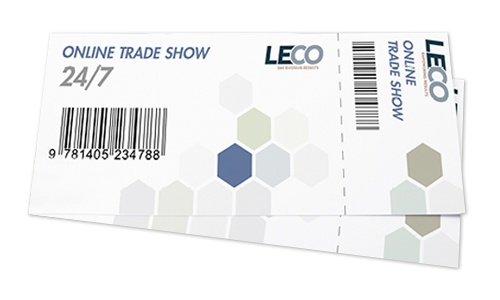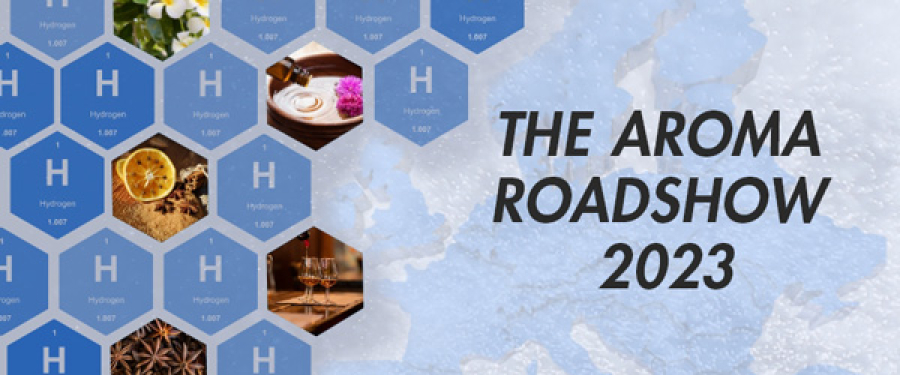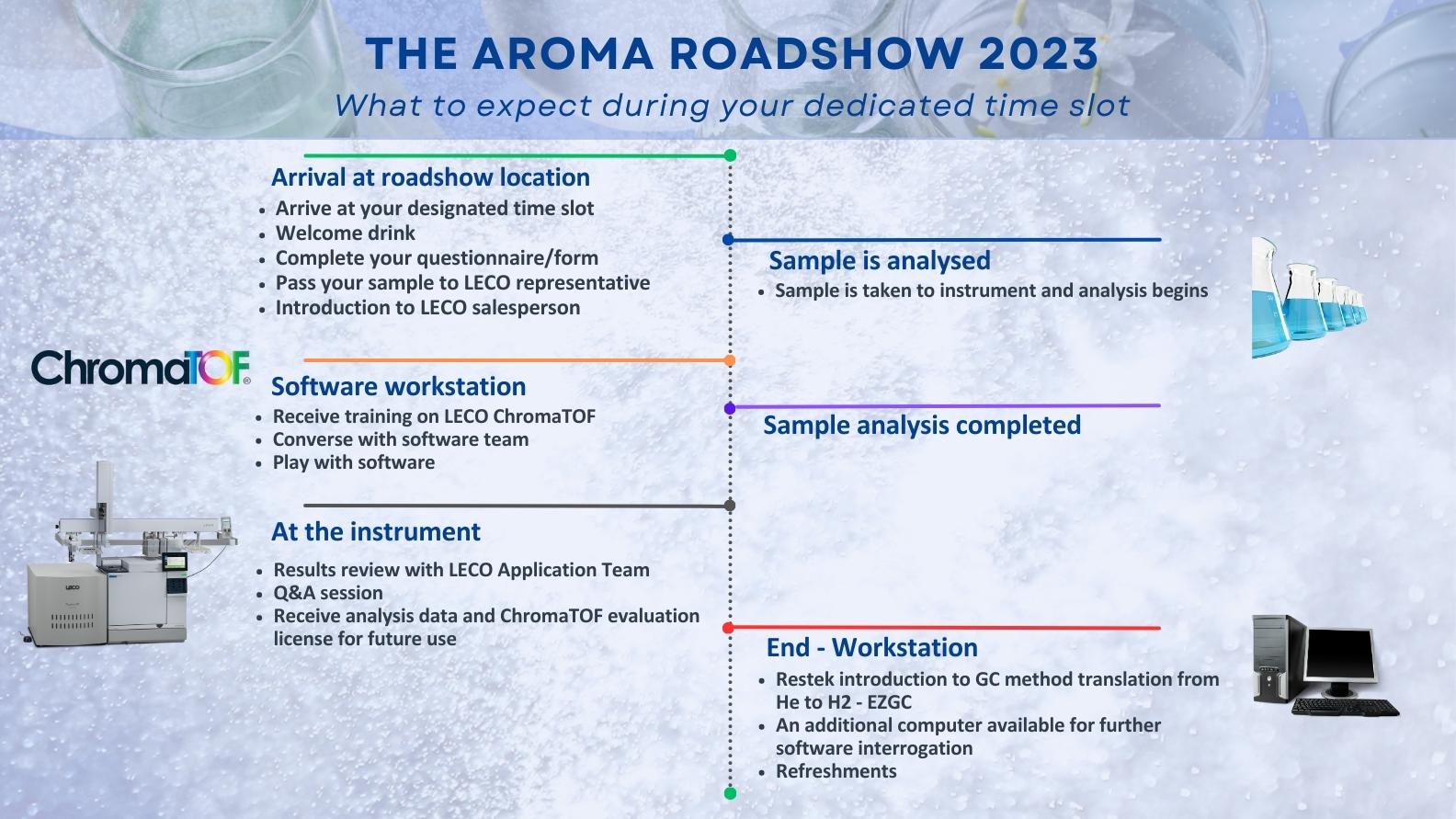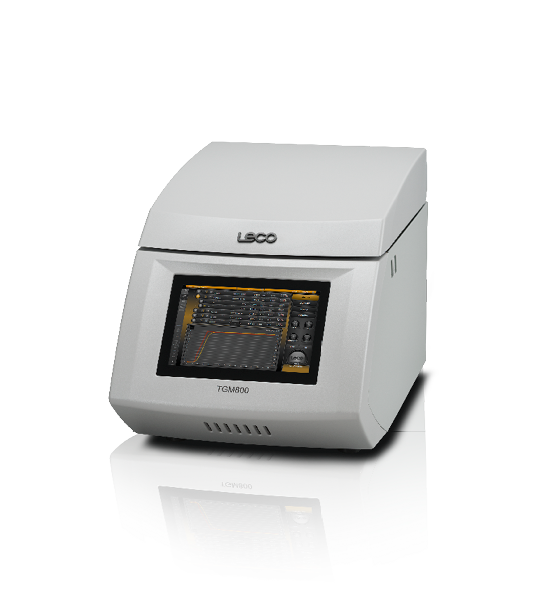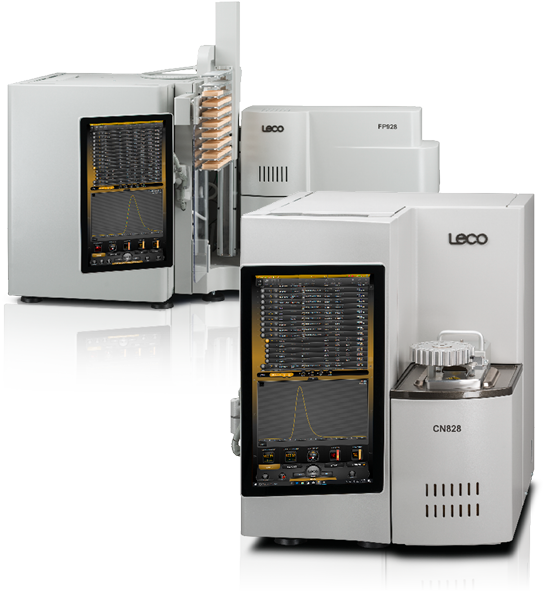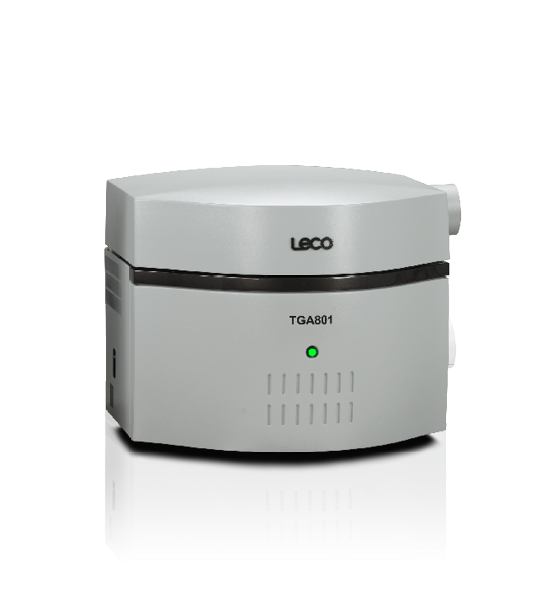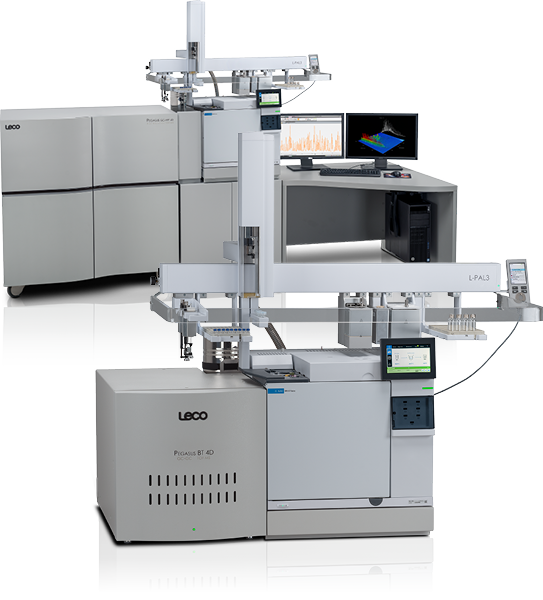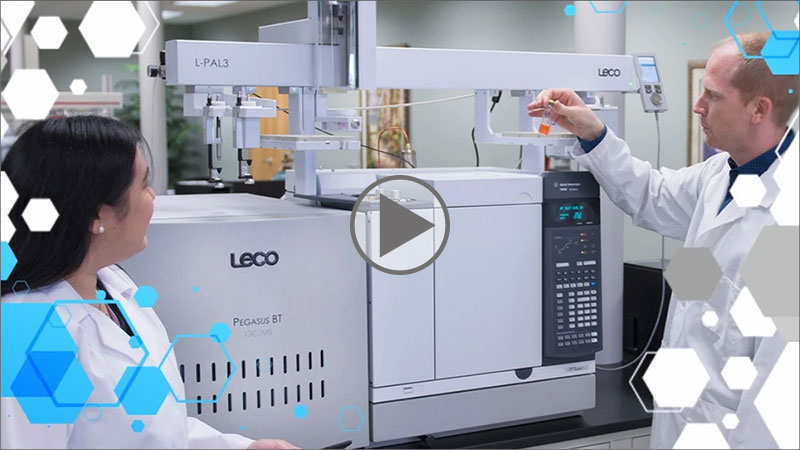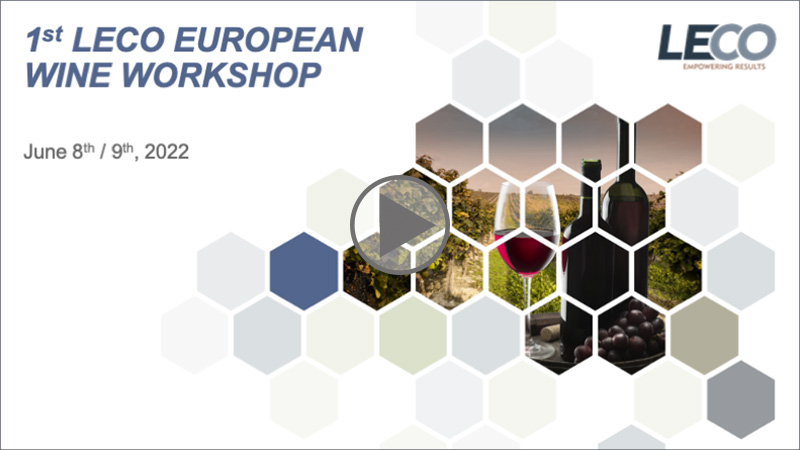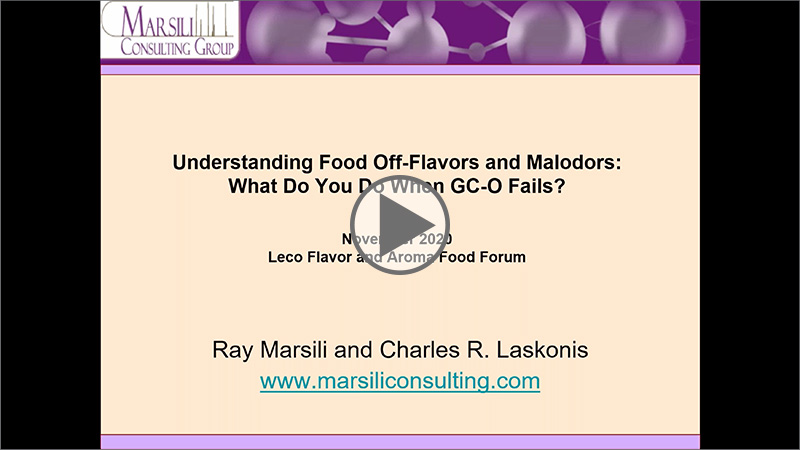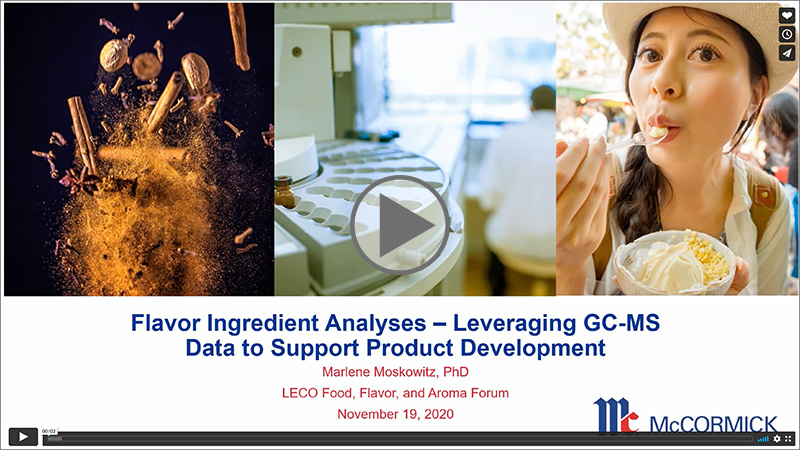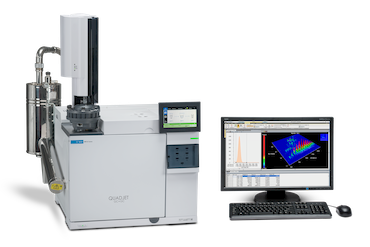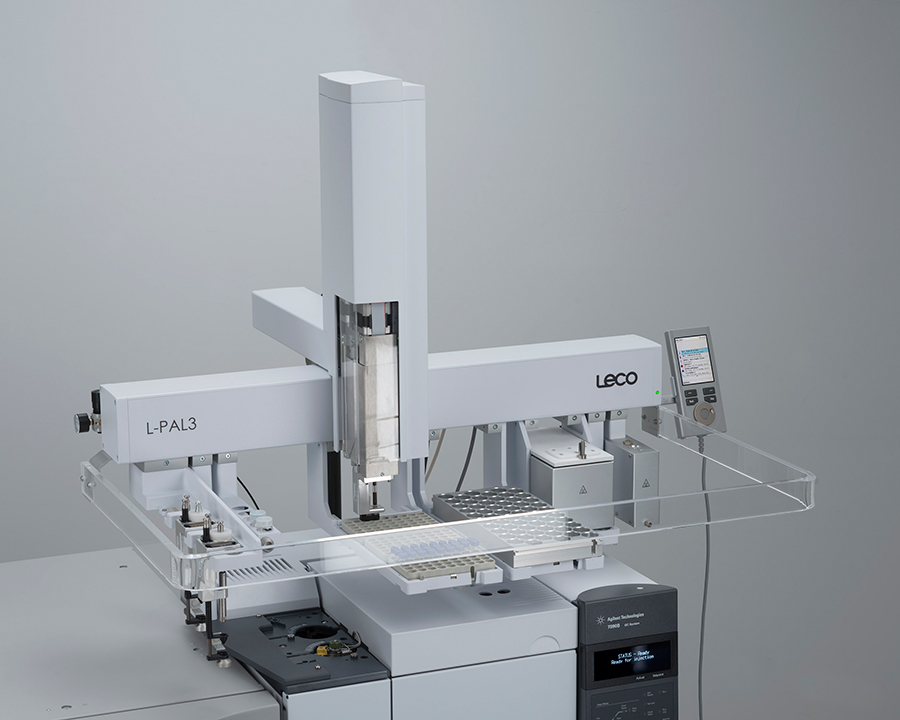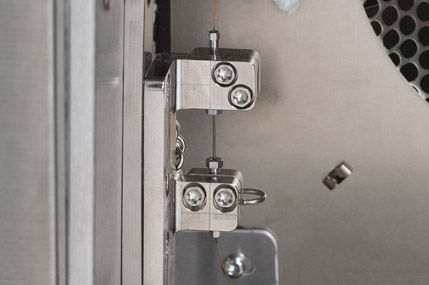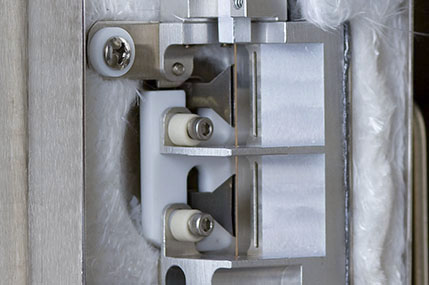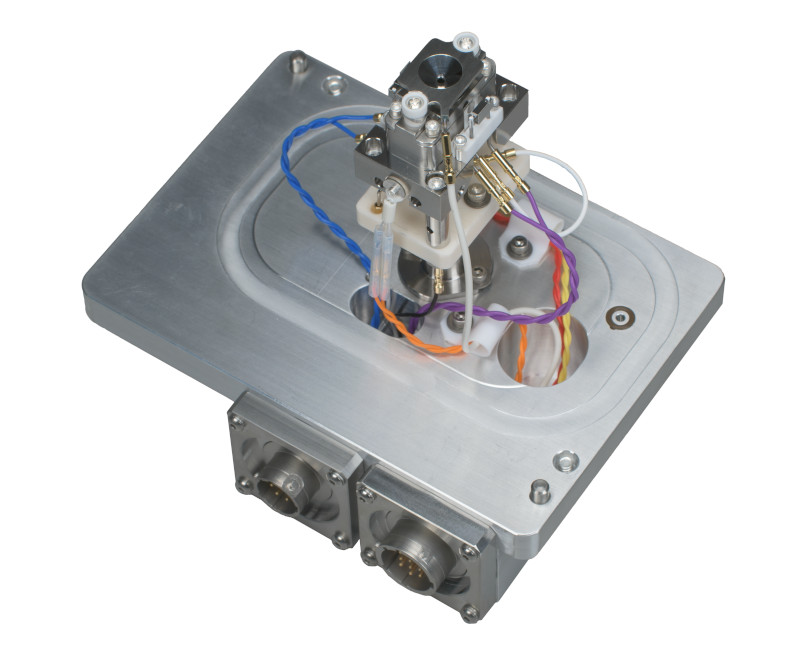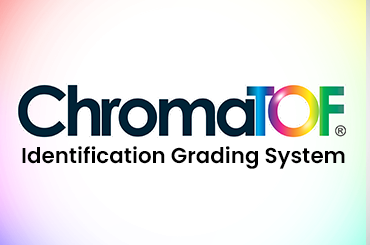
 LECO
Empowering Results
LECO
Empowering Results
Afficher les éléments par tag : Arôme
Explore the Fascinating World of Separation Science
The very first GC-MS was a GC-TOFMS which was built in 1947. The information it provided was much too large to record, and it was not until the mid-1990s when LECO introduced the first fast GC-TOFMS, that GC-TOFMS became a useable tool for researchers and analysts. Followed a few years later by LECO’s introduction of the first GC×GC-TOFMS.
Today, LECO’s Separation Science products are recognised across the globe as leading advanced technology innovations in TOFMS Mass Spectrometry and Comprehensive two-dimensional Chromatography.
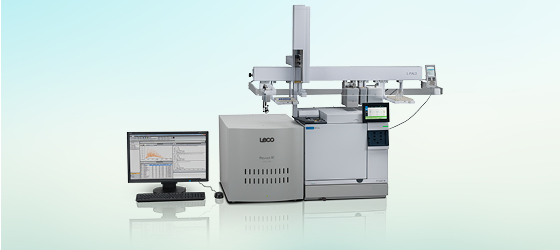
PEGASUS® BT GC-TOFMS
GC Time-Of-Flight Mass Spectrometer
Today‘s laboratories are being asked for more everyday – more samples run, more data acquired, more chemical information processed, and more results achieved – all in less time, for less money. ...
The Pegasus BT allows you to achieve all you need from a single sample run, while powerful and user-friendly ChromaTOF® software processes your data and removes the guesswork involved with analyte identification, quantitation, and reporting. The Pegasus BT gives users more uptime, better data, and an increase in overall productivity and efficiency.
Le spectromètre de masse à temps de vol (time-of-flight mass spectrometer, TOFMS) est idéal pour découvrir de nouveaux composés dans votre échantillon, pour quantifier des composés ciblés dans des échantillons complexes et pour augmenter le rendement car compatible avec la "fast GC".
► Download the free whitepaper and brochure
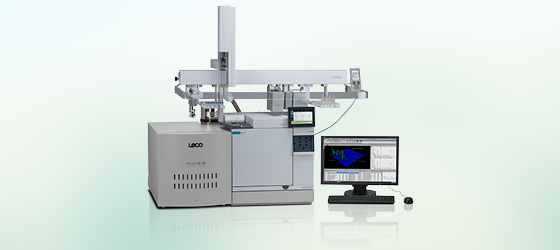
PEGASUS® BT 4D GCxGC-TOFMS
GC×GC Time-Of-Flight Mass Spectrometer
The Pegasus BT 4D offers enhanced sensitivity by coupling our benchtop Pegasus BT with a high-performance GC×GC modulation system. This combination gives the Pegasus BT 4D the ability to interrogate challenging samples ...
... where the best sensitivity is needed. Des fonctionnalités logiciel et instrument uniques et puissantes simplifient la quantification, ainsi que l’utilisation et la compréhension de la GCxGC. Our thermal modulation system, the QuadJet™, is recognised as the gold standard in GC×GC modulation, providing the highest sensitivity available on the market - ideal for analysing the most complex samples.
One of the main advantages of LECO’s GC×GC-TOFMS is its ability to provide vastly improved peak capacity and resolution than traditional GC-MS systems. It also offers comprehensive information about the sample by separating compounds based on two different properties (volatility and polarity). Combining GC×GC with TOFMS is an ultimate solution for the analysis of complex samples.
► Download the free brochure
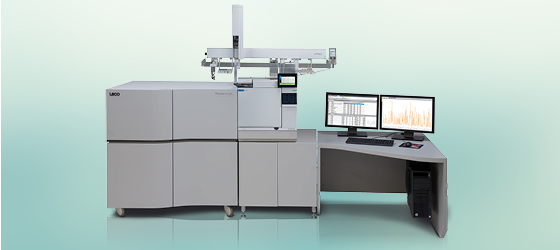
PEGASUS® GC-HRT+
High Resolution Time-Of-Flight Mass Spectrometer
Now with even more sensitivity than ever before, the Pegasus GC-HRT+ is the perfect tool for meeting the challenges of today’s highly complex analytical demands. ...
This high-resolution mass spectrometer features industry leading mass accuracy, full mass range acquisition with exceptional speed, full mass range acquisition with exceptional speed, isotopic abundance and mass resolution, all available in a single injection.
Folded Flight Path® (FFP®) technology and a novel data acquisition system enables simultaneous resolutions of over 50,000 FWHM, mass accuracies less than 1 ppm, and acquisition rates up to 200 spectra/second, without the need to adjust tuning or parameters. Thus, facilitating rich analyte finding and high-confidence analyte identification.
► Download the free brochure
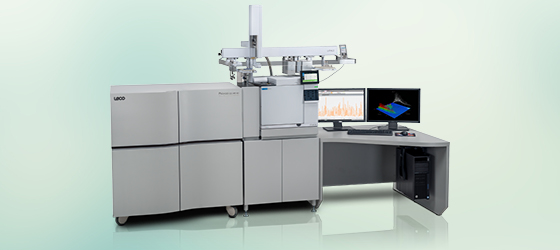
PEGASUS® GC-HRT+ 4D
HR GC×GC Time-Of-Flight Mass Spectrometer
The Pegasus GC-HRT+ 4D combines the highest performance GC×GC and TOFMS tools on the market with High Resolution Deconvolution® (HRD®). Ideal for the most complex samples, ...
... users are able to find more analytes than ever before and confidently identify unknown components.
The Pegasus GC-HRT+ 4D takes advantage of four dimensions of separation and resolution:
- 1st dimension chromatographic resolution
- 2nd dimension chromatographic resolution
- High mass resolution and exceptional mass accuracy
- High Resolution Deconvolution (HRD) from the leaders in deconvolution
ChromaTOF brand software, designed specifically for HRT+ instrumentation and GC×GC support, adds advanced qualitative and quantitative capabilities to an all-in-one user-friendly data system.
► Download the free brochure
Examples of LECO Separation Science Applications
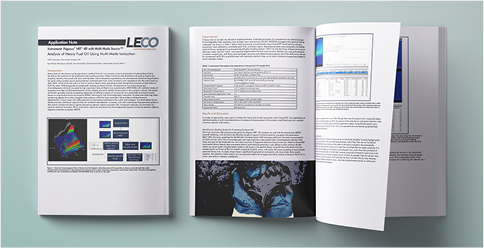
Pétrole
Comprehensive Two-Dimensional Gas Chromatography (GC×GC) has proven to be an extremely valuable analytical technique for the petroleum industry due to its ability to substantially increase the chromatographic peak capacity beyond that of traditional single-dimension gas chromatography. Pairing GC×GC with Time-of Flight Mass Spectrometry (TOFMS) provides unsurpassed characterization capabilities due to the separation power of GC×GC and the ability of TOFMS to provide rich data.
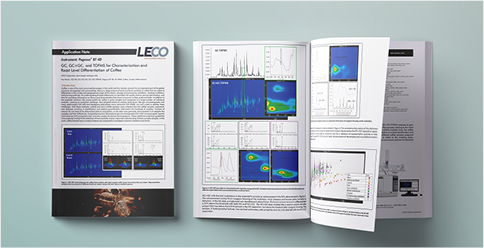
Food Testing
The characterization and safety testing of food and food constitutions can be extremely challenging depending on the complexity and the matrix. The LECO GC×GC TOFMS technology provides a highly powerful separation and remarkable identification allowing for improved workflows. More insights thanks to the advanced technology in combination with LECO’s ChromaTOF® brand software deconvolution algorithm and advanced data analysis tool will improve your Food Quality & Safety Testing and Food R&D. Here we demonstrate the aroma analsyis of two types of coffee and coffee packaging and filter leachates.

Perfume and Cosmetics
LECO‘s GC×GC-TOFMS is a valuable asset in the production of cosmetics and perfumes that align with Islamic principles. It can be used to identify the ingredients and detect any prohibited substances such as alcohol or non-halal animal-derived ingredients.
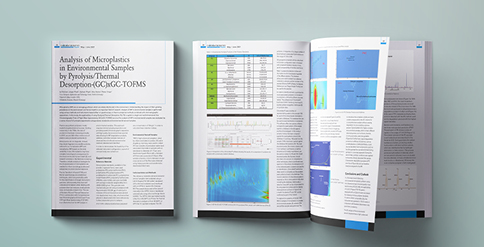
Analyse environnementale
Microplastics are an emerging pollutant which are widely distributed in the environment. Understanding the impact of their growing prevalence on the environment and human health is an important field of research. LECO‘s GC×GC-TOFMS can be used to monitor environmental pollution and air and water quality thus aiding to enforce regulations and ensure the preservation of our environment.

Métabolomique
LECO’s key advantage is the ability to identify and discover more metabolites than other similar technologies. La vitesse de notre acquisition en "full-scan" est incomparable, et si elle est combinée avec la puissance de l'algorithme de déconvolution du logiciel LECO ChromaTOF, permet une caractérisation des métabolomes sans précédent. Nos instruments ont été validés par les chercheurs les plus exigeants du domaine.
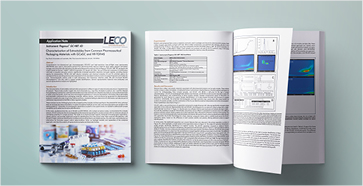
Extractables and Leachables
The characterization of extractable and leachable components from a wide range of materials is an important area of research. Information about extractable and leachable components from packaging and delivery devices for pharmaceutical products is a particular area of growing interest. Analytical testing results on this topic are part of many regulatory submission requirements to the FDA. ...
USP 1663 provides guidance on extractables testing and a variety of analytical approaches can meet compliance. High resolution MS is often considered necessary for identification of unknowns, and sample complexity and low-level detection continue to challenge these analyses. Here, we demonstrate a workflow that uses comprehensive two-dimensional gas chromatography (GC×GC) with HR-TOFMS to help address these challenges.
► App Note | Characterizing Extractables by GC×GC & HR-TOFMS
FAQ – Separation Science
Answer:
Gas chromatography separates components in a mixture by utilizing a thin silica tube coated with a stationary phase. The components, carried by a gas (the mobile phase), move at different speeds based on their affinities for the stationary phase. This differential migration leads to the separation of the components, allowing for their individual analysis and identification.
Alternative response:
- Gas chromatography is a technique for separating a mixture of volatile analytes
- The analytes are transported by a mobile phase (the carrier gas)
- Become distributed between the mobile phase and a stationary phase
- The Stationary Phase is attached to the inside of a very fine column
- Phases are typically characterised by their polarity
- A polar analyte will be retained by polar column for longer than a non-polar analyte
- and vica versa
Answer:
LECO uses Agilent 8890 chromatography. The gas chromatograph includes the following features:
- Compatibility and perfect integration with the mass spectrometer
- Automatic regulation of gas flows
- Agilent supported inlets: Split/Splitless (SSL), Multimode (MMI), Programmable temperature Vaporizer (PTV) etc.
- Programmable oven, up to 450 °C
- Chromatograph compatible with Fast-GC
- The GC is completely controlled by and integrated into LECO’s ChromaTOF software
Answer:
The LECO mass spectrometer is connected to the GC via a heated transfer line. The LECO GC-TOF allows you to have a 'full range' acquisition, without compromise, then a targeted and/or non-targeted data exploitation depending on what you want to do.
It consists of an EI (Electronic Impact) source, a 70 cm flight tube, a reflectron and a detector. Vacuum is provided by an internal turbomolecular pump connected to an external secondary pump.

Answer:
The mass range of the Pegasus BT is from 10 to 1500 m/z. All masses are collected all the time, unlike quadrupole instruments that collect a single mass at a time (quadrupole scanning mode is single ion monitoring, SIM, quickly scanning across the mass range).
Answer:
GC×GC-TOFMS can detect discrepancies in the composition of food products, helping to expose fraudulent claims of Halal certification and ensure consumer confidence in authentic Halal products.
Answer:
By examining the chemical composition of inks and pigments, GC×GC-TOFMS provides insights into the materials used in Islamic calligraphy and manuscripts, aiding in their preservation and authentication. An example of similar work can be read in this publication on analysing the paints used by Leonardo Da Vinci.
Answer:
LECO’s GC×GC-TOFMS system utilizes two columns with different separation mechanisms, providing enhanced chromatographic resolution for the analysis of complex mixtures. In one dimension the analytes are separated by polarity, or according to boiling point. An additional dimension separates according to an alternative property, of which there are many. This results in a 3D image – the two dimensions of separation and the abundance of the analytes in the third dimension.
Answer:
LECO's StayClean® ion source originates in the requirement for a fast source to match the speed of the TOFMS. Accomplished by reducing ion to ion interactions, such as with the walls of the source. The source was thus designed without walls – so there is nothing to clean. Massively reduced downtimes, especially for complex matrices and more reproducible results.
Answer:
Yes! With superior separation power and precision, LECO’s GC×GC-TOFMS system can uncover hidden details and confidently identify components, even in the most intricate mixtures:
- Increases detectability
- Removes analytes from matrix interference
- Separates co-elluting peaks
- Creates cleaner peaks, which match closer with libraries
- Creates structured chromatograms thus further improving identification confidence
Answer:
The cryogenic Quad Jet modulator consistently delivers reproducible quantitative results not only within the lab but also between labs worldwide. This is achieved because:
- There are two cold jets. So, eluent from the primary column does not flow into the secondary column by mistake
- The distance between cold zones is identical in every system worldwide, unlike other systems that require manual adjustment and intervention
- The modulation is completely computer controlled. This along with the 2 separate cold zones, allows for variable modulation periods in the same analysis, vastly improving separation across the chromatogram
- In the same way the primary column is temperature controlled in the primary oven, the secondary column is also independently controlled, allowing for total control of the chromatogram along the entire column setup
These four features not only improve separation and control, they are also unique to the LECO QuadJet.
Answer:
By combining comprehensive two-dimensional gas chromatography (GC×GC) with high-speed, high-sensitivity time-of-flight mass spectrometry (TOFMS), LECO's GC×GC-TOFMS can separate and identify the complex mixtures of flavours and fragrances in food samples with detail and precision.
Answer:
Yes! LECO’s GC×GC-TOFMS is an excellent tool for non-intentionally added substances (NIAS) analysis in food safety. It allows for the comprehensive analysis of complex food samples, ensuring the detection and identification of potential contaminants and unwanted substances. For example, LECO’s MOSH/MOAH solution is widely recognised as the most comprehensive and rigorous analyser for mineral oil contamination in food stuffs.
Answer:
LECO’s GC×GC technology utilizes two stages of separation, significantly increasing resolution and analysis power compared to traditional gas chromatography. This allows for the detailed separation and identification of complex mixtures with unparalleled precision.
Answer:
LECO’s TOFMS technology offers excellent sensitivity, speed, and resolution in mass spectrometry. By fragmenting and ionizing analyte molecules and separating the fragments based on their mass-to-charge ratio, LECO's TOFMS enables highly accurate identification and detection of compounds in samples. The system not only records to a computer at high speed, it detects at a rate of 32,000 Hz thus producing a very high level of accuracy.
Answer:
GC×GC-TOFMS enables the analysis of dietary supplements for the presence of non-compliant ingredients, such as animal-derived gelatine, ensuring that the products meet the strict requirements of Halal certification.
Answer:
GC×GC-TOFMS is a valuable tool for monitoring air and soil quality near Islamic sacred sites, identifying pollutants that may pose a risk to their preservation and guiding conservation efforts. As an example, Imperial College London have utilised a LECO Pegasus BT 4D to identify microplastics in the air of London. You can read about it here.
Answer:
LECO’s GC×GC-TOFMS system utilizes Time-of-Flight Mass Spectrometry (TOFMS), which provides high-speed detection of ionized compounds based on their mass-to-charge ratio.
Answer:
LECO provides software for data analysis, enabling compound identification, quantification, and other types of analysis based on the mass spectra obtained from the TOFMS.
Answer:
LECO’s StayClean ion source, a standard feature in every Pegasus BT GC-TOFMS and GC×GC-TOFMS system, flushes neutrals and contaminants continuously. This virtually eliminates the need for routine maintenance, allowing you to spend less time on upkeep and more time on your research.
Answer:
Sample handling is crucial in GC-MS analysis. LECO employs advanced sample handling robots called Autosamplers that can handle samples in three dimensions of space. These robots ensure precise and consistent sample preparation, ranging from simple liquid injections to complex processes like chemical reactions, extractions, and accurate dilutions.
Answer:
The first GC-MS was a GC-TOFMS developed in the 1950s. However, the technique was too powerful for data recording at the time. In the mid-1990s the first GC-TOFMS capable of recording the data for processing was developed by LECO. This breakthrough in fast GC-TOFMS technology allowed researchers and analysts to utilize the capabilities of GC-TOFMS for their analytical needs.
Answer:
By combining two-dimensional separation, robust ionization, and high-speed TOFMS detection, and patented deconvolution algorithms LECO's GC×GC-TOFMS system offers a powerful solution for analysing complex mixtures with enhanced resolution, sensitivity, and separation power.
Answer:
By analysing the chemical composition of materials used in ancient Islamic artifacts, GC×GC-TOFMS assists in determining their authenticity, providing valuable insights into historical and cultural heritage. The chemical composition of such artifacts are extremely complex so utilising multidimensional chromatography techniques with high speed TOFMS, a chemical profile can be created. Furthermore, LECO’s post processing software packages, ChromaTOF Tile and ChromaTOF Sync can identify differences between samples to compare artifacts and identify biomarkers.
Let LECO help you
find the right instruments for your needs.
Si vous souhaitez en savoir plus sur nos produits et solutions pour l’analyse de produits agroalimentaires, réservez un billet gratuit pour notre salon virtuel ou programmez une démonstration en ligne pour avoir un aperçu plus précis de nos instruments.
Explore the Fascinating World of Separation Science
The very first GC-MS was a GC-TOFMS which was built in 1947. The information it provided was much too large to record, and it was not until the mid-1990s when LECO introduced the first fast GC-TOFMS, that GC-TOFMS became a useable tool for researchers and analysts. Followed a few years later by LECO’s introduction of the first GC×GC-TOFMS.
Today, LECO’s Separation Science products are recognised across the globe as leading advanced technology innovations in TOFMS Mass Spectrometry and Comprehensive two-dimensional Chromatography.

PEGASUS® BT GC-TOFMS
GC Time-Of-Flight Mass Spectrometer
Today‘s laboratories are being asked for more everyday – more samples run, more data acquired, more chemical information processed, and more results achieved – all in less time, for less money. ...
The Pegasus BT allows you to achieve all you need from a single sample run, while powerful and user-friendly ChromaTOF® software processes your data and removes the guesswork involved with analyte identification, quantitation, and reporting. The Pegasus BT gives users more uptime, better data, and an increase in overall productivity and efficiency.
Le spectromètre de masse à temps de vol (time-of-flight mass spectrometer, TOFMS) est idéal pour découvrir de nouveaux composés dans votre échantillon, pour quantifier des composés ciblés dans des échantillons complexes et pour augmenter le rendement car compatible avec la "fast GC".
► Download the free whitepaper and brochure

PEGASUS® BT 4D GCxGC-TOFMS
GC×GC Time-Of-Flight Mass Spectrometer
The Pegasus BT 4D offers enhanced sensitivity by coupling our benchtop Pegasus BT with a high-performance GC×GC modulation system. This combination gives the Pegasus BT 4D the ability to interrogate challenging samples ...
... where the best sensitivity is needed. Des fonctionnalités logiciel et instrument uniques et puissantes simplifient la quantification, ainsi que l’utilisation et la compréhension de la GCxGC. Our thermal modulation system, the QuadJet™, is recognised as the gold standard in GC×GC modulation, providing the highest sensitivity available on the market - ideal for analysing the most complex samples.
One of the main advantages of LECO’s GC×GC-TOFMS is its ability to provide vastly improved peak capacity and resolution than traditional GC-MS systems. It also offers comprehensive information about the sample by separating compounds based on two different properties (volatility and polarity). Combining GC×GC with TOFMS is an ultimate solution for the analysis of complex samples.
► Download the free brochure

PEGASUS® GC-HRT+
High Resolution Time-Of-Flight Mass Spectrometer
Now with even more sensitivity than ever before, the Pegasus GC-HRT+ is the perfect tool for meeting the challenges of today’s highly complex analytical demands. ...
This high-resolution mass spectrometer features industry leading mass accuracy, full mass range acquisition with exceptional speed, full mass range acquisition with exceptional speed, isotopic abundance and mass resolution, all available in a single injection.
Folded Flight Path® (FFP®) technology and a novel data acquisition system enables simultaneous resolutions of over 50,000 FWHM, mass accuracies less than 1 ppm, and acquisition rates up to 200 spectra/second, without the need to adjust tuning or parameters. Thus, facilitating rich analyte finding and high-confidence analyte identification.
► Download the free brochure

PEGASUS® GC-HRT+ 4D
HR GC×GC Time-Of-Flight Mass Spectrometer
The Pegasus GC-HRT+ 4D combines the highest performance GC×GC and TOFMS tools on the market with High Resolution Deconvolution® (HRD®). Ideal for the most complex samples, ...
... users are able to find more analytes than ever before and confidently identify unknown components.
The Pegasus GC-HRT+ 4D takes advantage of four dimensions of separation and resolution:
- 1st dimension chromatographic resolution
- 2nd dimension chromatographic resolution
- High mass resolution and exceptional mass accuracy
- High Resolution Deconvolution (HRD) from the leaders in deconvolution
ChromaTOF brand software, designed specifically for HRT+ instrumentation and GC×GC support, adds advanced qualitative and quantitative capabilities to an all-in-one user-friendly data system.
► Download the free brochure
Examples of LECO Separation Science Applications

Pétrole
Comprehensive Two-Dimensional Gas Chromatography (GC×GC) has proven to be an extremely valuable analytical technique for the petroleum industry due to its ability to substantially increase the chromatographic peak capacity beyond that of traditional single-dimension gas chromatography. Pairing GC×GC with Time-of Flight Mass Spectrometry (TOFMS) provides unsurpassed characterization capabilities due to the separation power of GC×GC and the ability of TOFMS to provide rich data.

Food Testing
The characterization and safety testing of food and food constitutions can be extremely challenging depending on the complexity and the matrix. The LECO GC×GC TOFMS technology provides a highly powerful separation and remarkable identification allowing for improved workflows. More insights thanks to the advanced technology in combination with LECO’s ChromaTOF® brand software deconvolution algorithm and advanced data analysis tool will improve your Food Quality & Safety Testing and Food R&D. Here we demonstrate the aroma analsyis of two types of coffee and coffee packaging and filter leachates.

Perfume and Cosmetics
LECO‘s GC×GC-TOFMS is a valuable asset in the production of cosmetics and perfumes that align with Islamic principles. It can be used to identify the ingredients and detect any prohibited substances such as alcohol or non-halal animal-derived ingredients.

Analyse environnementale
Microplastics are an emerging pollutant which are widely distributed in the environment. Understanding the impact of their growing prevalence on the environment and human health is an important field of research. LECO‘s GC×GC-TOFMS can be used to monitor environmental pollution and air and water quality thus aiding to enforce regulations and ensure the preservation of our environment.

Métabolomique
LECO’s key advantage is the ability to identify and discover more metabolites than other similar technologies. La vitesse de notre acquisition en "full-scan" est incomparable, et si elle est combinée avec la puissance de l'algorithme de déconvolution du logiciel LECO ChromaTOF, permet une caractérisation des métabolomes sans précédent. Nos instruments ont été validés par les chercheurs les plus exigeants du domaine.

Extractables and Leachables
The characterization of extractable and leachable components from a wide range of materials is an important area of research. Information about extractable and leachable components from packaging and delivery devices for pharmaceutical products is a particular area of growing interest. Analytical testing results on this topic are part of many regulatory submission requirements to the FDA. ...
USP 1663 provides guidance on extractables testing and a variety of analytical approaches can meet compliance. High resolution MS is often considered necessary for identification of unknowns, and sample complexity and low-level detection continue to challenge these analyses. Here, we demonstrate a workflow that uses comprehensive two-dimensional gas chromatography (GC×GC) with HR-TOFMS to help address these challenges.
► App Note | Characterizing Extractables by GC×GC & HR-TOFMS
FAQ – Separation Science
Answer:
Gas chromatography separates components in a mixture by utilizing a thin silica tube coated with a stationary phase. The components, carried by a gas (the mobile phase), move at different speeds based on their affinities for the stationary phase. This differential migration leads to the separation of the components, allowing for their individual analysis and identification.
Alternative response:
- Gas chromatography is a technique for separating a mixture of volatile analytes
- The analytes are transported by a mobile phase (the carrier gas)
- Become distributed between the mobile phase and a stationary phase
- The Stationary Phase is attached to the inside of a very fine column
- Phases are typically characterised by their polarity
- A polar analyte will be retained by polar column for longer than a non-polar analyte
- and vica versa
Answer:
LECO uses Agilent 8890 chromatography. The gas chromatograph includes the following features:
- Compatibility and perfect integration with the mass spectrometer
- Automatic regulation of gas flows
- Agilent supported inlets: Split/Splitless (SSL), Multimode (MMI), Programmable temperature Vaporizer (PTV) etc.
- Programmable oven, up to 450 °C
- Chromatograph compatible with Fast-GC
- The GC is completely controlled by and integrated into LECO’s ChromaTOF software
Answer:
The LECO mass spectrometer is connected to the GC via a heated transfer line. The LECO GC-TOF allows you to have a 'full range' acquisition, without compromise, then a targeted and/or non-targeted data exploitation depending on what you want to do.
It consists of an EI (Electronic Impact) source, a 70 cm flight tube, a reflectron and a detector. Vacuum is provided by an internal turbomolecular pump connected to an external secondary pump.

Answer:
The mass range of the Pegasus BT is from 10 to 1500 m/z. All masses are collected all the time, unlike quadrupole instruments that collect a single mass at a time (quadrupole scanning mode is single ion monitoring, SIM, quickly scanning across the mass range).
Answer:
GC×GC-TOFMS can detect discrepancies in the composition of food products, helping to expose fraudulent claims of Halal certification and ensure consumer confidence in authentic Halal products.
Answer:
By examining the chemical composition of inks and pigments, GC×GC-TOFMS provides insights into the materials used in Islamic calligraphy and manuscripts, aiding in their preservation and authentication. An example of similar work can be read in this publication on analysing the paints used by Leonardo Da Vinci.
Answer:
LECO’s GC×GC-TOFMS system utilizes two columns with different separation mechanisms, providing enhanced chromatographic resolution for the analysis of complex mixtures. In one dimension the analytes are separated by polarity, or according to boiling point. An additional dimension separates according to an alternative property, of which there are many. This results in a 3D image – the two dimensions of separation and the abundance of the analytes in the third dimension.
Answer:
LECO's StayClean® ion source originates in the requirement for a fast source to match the speed of the TOFMS. Accomplished by reducing ion to ion interactions, such as with the walls of the source. The source was thus designed without walls – so there is nothing to clean. Massively reduced downtimes, especially for complex matrices and more reproducible results.
Answer:
Yes! With superior separation power and precision, LECO’s GC×GC-TOFMS system can uncover hidden details and confidently identify components, even in the most intricate mixtures:
- Increases detectability
- Removes analytes from matrix interference
- Separates co-elluting peaks
- Creates cleaner peaks, which match closer with libraries
- Creates structured chromatograms thus further improving identification confidence
Answer:
The cryogenic Quad Jet modulator consistently delivers reproducible quantitative results not only within the lab but also between labs worldwide. This is achieved because:
- There are two cold jets. So, eluent from the primary column does not flow into the secondary column by mistake
- The distance between cold zones is identical in every system worldwide, unlike other systems that require manual adjustment and intervention
- The modulation is completely computer controlled. This along with the 2 separate cold zones, allows for variable modulation periods in the same analysis, vastly improving separation across the chromatogram
- In the same way the primary column is temperature controlled in the primary oven, the secondary column is also independently controlled, allowing for total control of the chromatogram along the entire column setup
These four features not only improve separation and control, they are also unique to the LECO QuadJet.
Answer:
By combining comprehensive two-dimensional gas chromatography (GC×GC) with high-speed, high-sensitivity time-of-flight mass spectrometry (TOFMS), LECO's GC×GC-TOFMS can separate and identify the complex mixtures of flavours and fragrances in food samples with detail and precision.
Answer:
Yes! LECO’s GC×GC-TOFMS is an excellent tool for non-intentionally added substances (NIAS) analysis in food safety. It allows for the comprehensive analysis of complex food samples, ensuring the detection and identification of potential contaminants and unwanted substances. For example, LECO’s MOSH/MOAH solution is widely recognised as the most comprehensive and rigorous analyser for mineral oil contamination in food stuffs.
Answer:
LECO’s GC×GC technology utilizes two stages of separation, significantly increasing resolution and analysis power compared to traditional gas chromatography. This allows for the detailed separation and identification of complex mixtures with unparalleled precision.
Answer:
LECO’s TOFMS technology offers excellent sensitivity, speed, and resolution in mass spectrometry. By fragmenting and ionizing analyte molecules and separating the fragments based on their mass-to-charge ratio, LECO's TOFMS enables highly accurate identification and detection of compounds in samples. The system not only records to a computer at high speed, it detects at a rate of 32,000 Hz thus producing a very high level of accuracy.
Answer:
GC×GC-TOFMS enables the analysis of dietary supplements for the presence of non-compliant ingredients, such as animal-derived gelatine, ensuring that the products meet the strict requirements of Halal certification.
Answer:
GC×GC-TOFMS is a valuable tool for monitoring air and soil quality near Islamic sacred sites, identifying pollutants that may pose a risk to their preservation and guiding conservation efforts. As an example, Imperial College London have utilised a LECO Pegasus BT 4D to identify microplastics in the air of London. You can read about it here.
Answer:
LECO’s GC×GC-TOFMS system utilizes Time-of-Flight Mass Spectrometry (TOFMS), which provides high-speed detection of ionized compounds based on their mass-to-charge ratio.
Answer:
LECO provides software for data analysis, enabling compound identification, quantification, and other types of analysis based on the mass spectra obtained from the TOFMS.
Answer:
LECO’s StayClean ion source, a standard feature in every Pegasus BT GC-TOFMS and GC×GC-TOFMS system, flushes neutrals and contaminants continuously. This virtually eliminates the need for routine maintenance, allowing you to spend less time on upkeep and more time on your research.
Answer:
Sample handling is crucial in GC-MS analysis. LECO employs advanced sample handling robots called Autosamplers that can handle samples in three dimensions of space. These robots ensure precise and consistent sample preparation, ranging from simple liquid injections to complex processes like chemical reactions, extractions, and accurate dilutions.
Answer:
The first GC-MS was a GC-TOFMS developed in the 1950s. However, the technique was too powerful for data recording at the time. In the mid-1990s the first GC-TOFMS capable of recording the data for processing was developed by LECO. This breakthrough in fast GC-TOFMS technology allowed researchers and analysts to utilize the capabilities of GC-TOFMS for their analytical needs.
Answer:
By combining two-dimensional separation, robust ionization, and high-speed TOFMS detection, and patented deconvolution algorithms LECO's GC×GC-TOFMS system offers a powerful solution for analysing complex mixtures with enhanced resolution, sensitivity, and separation power.
Answer:
By analysing the chemical composition of materials used in ancient Islamic artifacts, GC×GC-TOFMS assists in determining their authenticity, providing valuable insights into historical and cultural heritage. The chemical composition of such artifacts are extremely complex so utilising multidimensional chromatography techniques with high speed TOFMS, a chemical profile can be created. Furthermore, LECO’s post processing software packages, ChromaTOF Tile and ChromaTOF Sync can identify differences between samples to compare artifacts and identify biomarkers.
Let LECO help you
find the right instruments for your needs.
Si vous souhaitez en savoir plus sur nos produits et solutions pour l’analyse de produits agroalimentaires, réservez un billet gratuit pour notre salon virtuel ou programmez une démonstration en ligne pour avoir un aperçu plus précis de nos instruments.
Attention All Aroma Enthusiasts!
The LECO Aroma Roadshow 2023 has concluded, and it was a remarkable journey that brought the world of aroma analysis closer to professionals across Europe. At LECO, we understand the value of your time, and our goal was to make expertise more accessible. We're thrilled to have had the opportunity to meet with you in person and demonstrate how LECO instrumentation and the use of hydrogen carrier gas can elevate your analytical capabilities.
Our team of friendly and knowledgeable application specialists provided live demonstrations of our cutting-edge instruments and software, enriching your understanding of aroma analysis. We are grateful for your active participation and insightful questions, which made this event a success.
While the LECO Aroma Roadshow 2023 has concluded, our commitment to advancing your knowledge and expertise continues. Stay tuned for more updates, resources, and future events from LECO
For any questions or further information, please contact: Cette adresse e-mail est protégée contre les spambots. Vous devez activer JavaScript pour l’afficher.

More about aroma analysis
If you missed our roadshow and want to delve deeper into the world of aroma analysis, please visit our aroma resources page. There, you'll find valuable insights and information to enhance your understanding of this fascinating field.
Program
At the LECO Aroma Roadshow, each event stop was thoughtfully designed to maximize the experience and deliver valuable insights for all attendees. The goal was to make the most of everyone's precious time.
During the dedicated time slots, our experts provided one-on-one assistance, addressing specific needs and answering questions that arose. Attendees had the chance to witness our instruments in action, all without disrupting their busy schedules.
The event was a collaborative exploration of data, where participants saved time and gained valuable insights. It was a unique opportunity for personalized guidance from experts tailored to sample data.
Comment pouvons-nous le faire ?
LECO instrumentation is robust and reliable, allowing us to set up methods in advance that will run in any environment.
Using hydrogen carrier gas vastly speeds up the acquisition process reducing run times by up to 75%.
The instrument will be set up to run your sample allowing our conversation to revolve around your data.
Sample
Our Sales Engineer will be in contact with you and will provide instructions on how to prepare your samples for live measurements. They will provide all the necessary information and collaborate with our team of application specialists to help you achieve exceptional results. With the goal of empowering your results, we're committed to ensuring your measurements are accurate and reliable. Should you not have specific requests, our team will also prepare test samples for measurement.

Roadshow Venues
Completed
18th or 19th April
Stockport, UK
LECO Instruments Ltd.
Unit 7, Rhino Court, Station View
Bramhall Moor Lane, Hazel Grove
Stockport SK7 5ER
Completed
26th or 27th April
Cambridge, UK
Element Cambridge
(formerly Anatune)
Unit 4, Wellbrook Court
Girton Rd, Girton
Cambridge CB3 0NA
Completed
2th or 3th May
Oberhausen, GER
SIM Scientific Instruments
Manufacturer GmbH
Im Erlengrund 21-23
46149 Oberhausen
Completed
25th or 26th May
Ferrara, IT
University of Ferrara
Via Luigi Borsari, 46
44121 Ferrara FE
Completed
25th or 26th May
Berlin, GER
LECO EATC
Max-Dohrn Strasse 8-10
Biotechpark, Building B 5.2
10589 Berlin
Completed
7th or 8th June
Liège, BEL
Université de Liège
Place du 20 Août 7
4000 Liège
Completed
29th or 30th June
Lyon, FR
Université de Lyon
92 Rue Pasteur
69007 Lyon
Completed
12th September
Messina, IT
Università degli Studi di Messina
Via G. Palatucci SNC
98168 Messina
Completed
14th or 15th November
Berlin, GER
LECO EATC
Max-Dohrn Strasse 8-10
Biotechpark, Building B 5.2
10589 Berlin
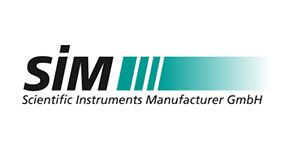
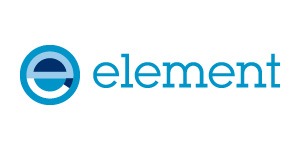


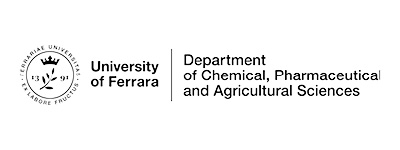
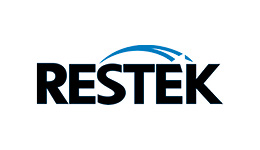
Let LECO help you find the right instruments for your need.
Si vous souhaitez en savoir plus sur nos produits et solutions pour l’analyse des arômes, réservez un billet gratuit pour notre salon virtuel ou programmez une démonstration en ligne pour avoir un aperçu plus précis de nos instruments.
Enhance your Food Analysis
Les instruments LECO analysent la qualité et la valeur nutritionnelle de nombreux produits agroalimentaires, des aliments crus aux produits finis prêts à la consommation. Benefit fom the advantages of our state-of-the-art solutions for your individual food analysis. Elevate your results and save your time.
Specific Advantages Including
- Moisture Determination – Loss on drying automated up to 16 samples simultaneously
- MOSH/MOAH Determination – Identify and quantify the source of contamination
- Detection of Pesticides – Even in the most difficult matrices
- Protein Determination after Dumas – Replacement of Kjeldahl; Results in ≈ 3 minutes fully matrix independent
- Aroma Profiling – Identify what you smell, but never see
Unlock the 2023 special issue of FoodLab Magazine now – Exclusively Available Here!

Explore our exclusive collection of expert articles on aroma, moisture & ash, MOSH/MOAH, and protein, developed in collaboration with FoodLab Magazine. Download now for the latest insights in the food industry.
Instrument Portfolio for Food Analysis
Your Solution For Cost Effective Food Analysis
Check out our broad product portfolio for food safety, nutrition, and moisture analysis. Benefit from the advantages of our state-of-the-art solutions for your individual food analysis.

MOSH MOAH Determination
Quels que soient les contraintes liées à votre préparation d'échantillon, exploitez toute la puissance de la technologie GCxGC & TOF de LECO pour résoudre les challenges de l'analyse MOSH et MOAH.

Determination of Moisture/Ash/Loss on Drying
An accurate determination of moisture content in food or agricultural products provides important information related to the food quality and safety.
White Paper | Protein Analysis - Dumas Vs. Kjeldahl
Have you ever wondered about this old discussion about „Dumas and Kjedahl“ and which one fits better to your needs in the field of protein analysis?
Read our lates white paper related to protein analysis by comparing the methods "Dumas vs. Kjeldahl". Get a concise overview about the theories of operation, and learn how the benefits of a LECO Dumas determinator can impact your workflow.
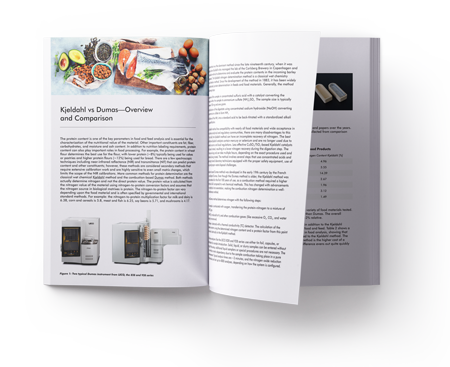
Let LECO help you find the right instruments for your needs.
Si vous souhaitez en savoir plus sur nos produits et solutions pour l’analyse de produits agroalimentaires, réservez un billet gratuit pour notre salon virtuel ou programmez une démonstration en ligne pour avoir un aperçu plus précis de nos instruments.
Solutions LECO pour l'analyse des arômes
Trouver les sources des défauts d’arôme est plus facile que jamais avec la technologie LECO GC-MS. Quantifiez et ciblez des échantillons en une seule injection à l’aide de la spectrométrie de masse à temps de vol de chromatographie en phase gazeuse bidimensionnelle LECO (CG×CG TOFMS).
Caractérisez les parfums naturels, matricez et décryptez les huiles essentielles complexes. Identifiez les arômes parasites et atypiques pour améliorer la qualité et la rentabilité. Consultez des exemples spécifiques avec nos notes d'application et nos webinaires pour savoir comment la technologie GC et GC×GC de LECO peut dynamiser votre laboratoire, ou obtenir des informations détaillées sur les instruments de LECO pour l'analyse sensorielle, des arômes et des parfums.
Dans ce qui suit, vous allez trouver un recueil de contenus selon l’analyse des arômes. Pour certains contenus, nous vous prions de bien vouloir envoyer notre formulaire. Après l’avoir rempli une fois, vous aurez accès à tous les fichiers.
Product portfolio
PEGASUS® BT GC-TOFMS and PEGASUS® BT 4D GC×GC-TOFMS
La fiabilité et la durabilité éprouvées de notre marque Pegasus dans une unité de paillasse pratique vous offrent plus de disponibilité, des données chimiques améliorées et une augmentation de la productivité et de l’efficacité globales.

Événements récents/Présentations à la demande
► « Webinaire sur les solutions de flux de travail améliorées pour GC-MS »
Découvrez comment des solutions instrumentales et logicielles de pointe s’associent pour améliorer vos applications de chromatographie en phase gazeuse unie et bidimensionnelle (GC-MS et GC×GC-MS).
Watch the video ...
► « Le 1er Atelier œnologique de LECO en Europe »
Regardez les différentes présentations d’experts sur le GC-TOF-MS / GC×GC-TOF-MS pour les analyses de vins et découvrez comment le GC-MS peut améliorer votre analyse quotidienne.
Watch the video ...
► « Défis et solutions dans le profilage des arômes (MDCW 2022) »
Vous avez manqué le webinaire de LECO lors du MDCW 2022 ?
Présentation de Lena M. Dubois sur les solutions aux défis rencontrés dans ..
Watch the video ...
► « Vers des aliments végétariens encore plus savoureux »
Hans-Gerd Janssen (Unilever) et Ed Rosing (Université de Wageningen) discutent de l’interprétation non ciblée des données GC×GC-MS pour l’avancement…
Watch the video ....
► « Comprendre les saveurs et les odeurs désagréables des aliments »
L'utilisation de la chromatographie en phase gazeuse-olfactométrie (GC-O) peut aider à identifier les composés odorants actifs dans les mélanges complexes. Mais que se passe-t-il si la GC-O …
Watch the video ...
► « Analyses d'ingrédients aromatiques par GCMS »
Marlene Moskowitz, PhD, chimiste analytique chez McCormick, explique comment leurs laboratoires tirent parti de la chromatographie en phase gazeuse …
Watch the video ...
Bibliothèque et publications sur l'analyse des arômes
Learn more about our solutions for aroma analysis and read our Application Notes. In the following, you are going to find a content compendium.
Application Notes
PEGASUS® BT GC-TOFMS
- Pairing Olfactory Detection with GC-MS to Clarify Identification of Isomers
- Characterization and Comparison of Whiskey Aroma Profiles with GC-TOFMS and Sync
- Differentiation of Baijiu Spirits
- Analysis of Citrus Essential Oils
- Comparison of Traditional Chardonnay and Buttery Chardonnay
- Sensitive Analysis of Tea Tree Essential Oil
- Brewery Process Monitoring
- Essential Oil Characterization
- Profil d’arôme chimique de la barre de chocolat noir
- Track Aging of an American IPA Beer at Different Storage Temperatures
- Monitoring of Furan Derivates and Key Aroma Species Simultaneously in Coffee and Coffee Substitutes
Application Notes
PEGASUS® BT 4D GC×GC-TOFMS
- Statistical Differentiation of Baijiu Spirits Using SPME-GC×GC-TOFMS and ChromaTOF® Tile Software
- Workflow for the Assessment of Key Aroma Compounds of Pumpernickel Bread Variations
- Comprehensive Evaluation of Scotch Whisky Aroma Profiles Using SPME-GC×GC-TOFMS
- Pesto Aroma Profile SPME
- Pesto ChromaTOF Tile SPME
- Frankincense and Myrrh: Visual Characterization and Comparison of Essential Oils
- Caractérisation de l’huile essentielle de citronnelle
- Caractérisation et différenciation des niveaux de torréfaction du café
- Discrimination de profils d’arôme du miel
- Improved Characterization and Differentiation of Perfume Samples
- Differentiating Original-Brand and Imitation Perfumes with GCxGC-TOFMS and ChromaTOF Tile
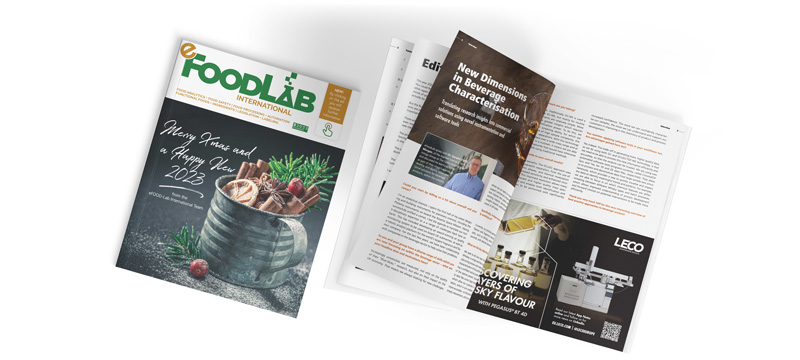
eFoodLab Article | New Dimensions in Beverage Characterisation
In this issue, eFoodLab published an interview with Dr. Geraint (Taff) Morgan of the Applied Science & Technology Group at The Open University, UK, who discussed his team's activities as part of their impact agenda to develop and deploy novel analytical solutions for beverage products within the industry.
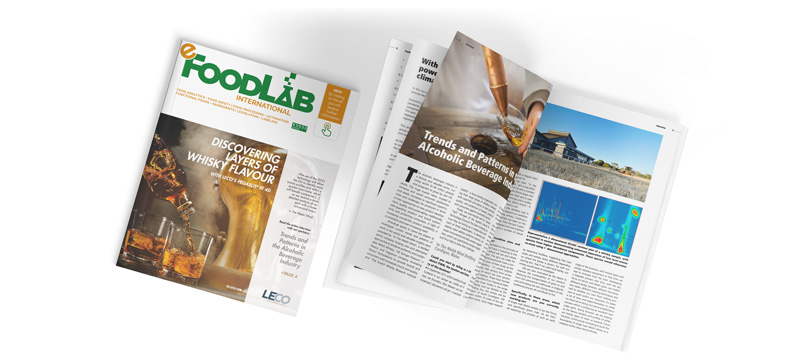
eFoodLab Article | Trends and Patterns in the Alcoholic Beverage Industry
eFoodLab spoke to some key players to investigate current trends and patterns of work in the sector and valuable insights were provided by "In The Welsh Wind", a distilled spirits company forging new and alternative approaches to produce authentic and sustainable Welsh Whiskey, "He Stringer Flavours", a flavour and fragrance company innovating flavour formulations to provide brands and consumers with increased choice and quality.
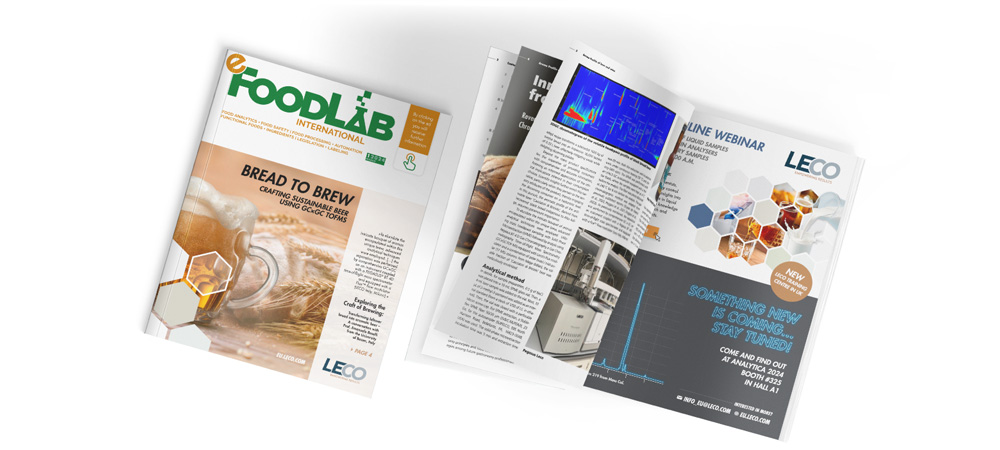
eFoodLab Article | Innovative Beer crafted from unsold bread
eFoodLab is talking about 'Cacciatori di Briciole' beer, exploring its aromatic intricacies through advanced gas chromatography techniques, a testament to sustainable brewing innovation.
Autres gammes d'instruments
Parcourez notre gamme de produits analytiques scientifiques pour l’analyse sensorielle, des arômes et des parfums afin de trouver l’instrument approprié à vos besoins spécifiques.
Le QuadJet™ SD de LECO est la solution idéale pour les échantillons qui arrivent dans votre laboratoire. En combinant la sensibilité du détecteur à ionisation de flamme (FID) avec la résolution chromatographique accrue de la chromatographie en phase gazeuse bidimensionnelle intégrale (CGxCG), le QuadJet SD fournit une meilleure analyse des composés présents dans votre échantillon qu’une analyse GC simple. Aucun autre système disponible sur le marché ne peut offrir la même réduction de bruit et d’erreur que le QuadJet SD.
Disponible exclusivement auprès de LECO, notre échantillonneur automatique L-PAL3 offre une capacité accrue de flacons, des injections GC sans discrimination (injections ultrarapides), un outil d’échange automatique de tête d'injecteur pour basculer entre les types d’injection (liquide, headspace ou micro-extraction en phase solide (SPME)) et la détection du fond des flacons pour éviter les injections incorrectes.
La façon la plus simple d'intégrer la GCxGC dans vos analyses quotidiennes
Simply GCxGC de LECO est un outil gratuit conçu pour vous guider tout au long du développement d’une méthode GCxGC optimisée pour vos échantillons complexes. Créez une méthode GCxGC à partir de zéro ou convertissez une méthode 1D existante en GCxGC.
Modulateur de flux GC×GC
Notre modulateur de flux FLUX GCxGC a été conçu avec un seul objectif en tête : rendre la GCxGC plus routinière, accessible et plus facile pour vous.
La modulation thermique offre les performances les plus élevées parmi tous les modulateurs disponibles pour GCxGC. D’autres types de modulateurs thermiques ou à base de vannes ne sont pas à hauteur de la robustesse, fiabilité et des performances du modulateur GCxGC de LECO.
Source d’ionisation pour la spectrométrie de masse par chromatographie en phase gazeuse
L’innovation du Multi-Mode Source™ (MMS™) profite de tous les avantages des trois modes d’ionisation les plus courants - ionisation électronique (EI), ionisation chimique positive (PCI) et ionisation chimique négative (NCI/ECNI) - et les combine en une seule source facile à utiliser. Plus de changement de matériel, plus de problèmes d’alignement :
avec le MMS, changer les modes d’ionisation est aussi simple que d'appuyer sur sur un bouton.
Développé exclusivement par LECO, ChromaTOF® est spécialement conçu pour répondre aux besoins des professionnels de laboratoire d’aujourd’hui en traitant et en analysant les grandes quantités de données acquises avec nos instruments à temps de vol.
Développé exclusivement par LECO, ChromaTOF® est spécialement conçu pour répondre aux besoins des professionnels de laboratoire d’aujourd’hui en traitant et en analysant les grandes quantités de données acquises avec nos instruments à temps de vol.
Apportez de la précision en masse et de une meilleure fiabilité pour l'identification de vos composés
Le système de confirmation des identifications (IGS) de LECO facilite le traitement des données en permettant aux utilisateurs de voir, de justifier et de rapporter rapidement les composés présents dans un échantillon, tout en ayant confiance dans le résultat.
Let LECO help you find the right instruments for your needs.
Si vous souhaitez en savoir plus sur nos produits et solutions pour l’analyse des arômes, réservez un billet gratuit pour notre salon virtuel ou programmez une démonstration en ligne pour avoir un aperçu plus précis de nos instruments.
Solutions LECO pour l'analyse des arômes
Trouver les sources des défauts d’arôme est plus facile que jamais avec la technologie LECO GC-MS. Quantifiez et ciblez des échantillons en une seule injection à l’aide de la spectrométrie de masse à temps de vol de chromatographie en phase gazeuse bidimensionnelle LECO (CG×CG TOFMS).
Caractérisez les parfums naturels, matricez et décryptez les huiles essentielles complexes. Identifiez les arômes parasites et atypiques pour améliorer la qualité et la rentabilité. Consultez des exemples spécifiques avec nos notes d'application et nos webinaires pour savoir comment la technologie GC et GC×GC de LECO peut dynamiser votre laboratoire, ou obtenir des informations détaillées sur les instruments de LECO pour l'analyse sensorielle, des arômes et des parfums.
Dans ce qui suit, vous allez trouver un recueil de contenus selon l’analyse des arômes. Pour certains contenus, nous vous prions de bien vouloir envoyer notre formulaire. Après l’avoir rempli une fois, vous aurez accès à tous les fichiers.
Product portfolio
PEGASUS® BT GC-TOFMS and PEGASUS® BT 4D GC×GC-TOFMS
La fiabilité et la durabilité éprouvées de notre marque Pegasus dans une unité de paillasse pratique vous offrent plus de disponibilité, des données chimiques améliorées et une augmentation de la productivité et de l’efficacité globales.

Événements récents/Présentations à la demande
► « Webinaire sur les solutions de flux de travail améliorées pour GC-MS »
Découvrez comment des solutions instrumentales et logicielles de pointe s’associent pour améliorer vos applications de chromatographie en phase gazeuse unie et bidimensionnelle (GC-MS et GC×GC-MS).
Cliquez ici pour regarder la vidéo.
► « Le 1er Atelier œnologique de LECO en Europe »
Regardez les différentes présentations d’experts sur le GC-TOF-MS / GC×GC-TOF-MS pour les analyses de vins et découvrez comment le GC-MS peut améliorer votre analyse quotidienne.
Complétez notre formulaire pour accéder à la vidéo.
► « Défis et solutions dans le profilage des arômes (MDCW 2022) »
Vous avez manqué le webinaire de LECO lors du MDCW 2022 ?
Présentation de Lena M. Dubois sur les solutions aux défis rencontrés dans ..
Complétez notre formulaire pour accéder à la vidéo.
► « Vers des aliments végétariens encore plus savoureux »
Hans-Gerd Janssen (Unilever) et Ed Rosing (Université de Wageningen) discutent de l’interprétation non ciblée des données GC×GC-MS pour l’avancement…
Complétez notre formulaire pour accéder à la vidéo.
► « Comprendre les saveurs et les odeurs désagréables des aliments »
L'utilisation de la chromatographie en phase gazeuse-olfactométrie (GC-O) peut aider à identifier les composés odorants actifs dans les mélanges complexes. Mais que se passe-t-il si la GC-O …
Complétez notre formulaire pour accéder à la vidéo.
► « Analyses d'ingrédients aromatiques par GCMS »
Marlene Moskowitz, PhD, chimiste analytique chez McCormick, explique comment leurs laboratoires tirent parti de la chromatographie en phase gazeuse …
Complétez notre formulaire pour accéder à la vidéo.
Bibliothèque et publications sur l'analyse des arômes
Learn more about our solutions for aroma analysis and read our Application Notes. In the following, you are going to find a content compendium. We kindly ask you to submit our form. Afterwards you‘ll get access to all the files.
Application Notes
PEGASUS® BT GC-TOFMS
Please complete the form to get access to all App Notes.
- Pairing Olfactory Detection with GC-MS to Clarify Identification of Isomers
- Characterization and Comparison of Whiskey Aroma Profiles with GC-TOFMS and Sync
- Differentiation of Baijiu Spirits
- Analysis of Citrus Essential Oils
- Comparison of Traditional Chardonnay and Buttery Chardonnay
- Sensitive Analysis of Tea Tree Essential Oil
- Brewery Process Monitoring
- Essential Oil Characterization
- Profil d’arôme chimique de la barre de chocolat noir
- Track Aging of an American IPA Beer at Different Storage Temperatures
- Monitoring of Furan Derivates and Key Aroma Species Simultaneously in Coffee and Coffee Substitutes
Application Notes
PEGASUS® BT 4D GC×GC-TOFMS
Please complete the form to get access to all App Notes.
- Statistical Differentiation of Baijiu Spirits Using SPME-GC×GC-TOFMS and ChromaTOF® Tile Software
- Workflow for the Assessment of Key Aroma Compounds of Pumpernickel Bread Variations
- Comprehensive Evaluation of Scotch Whisky Aroma Profiles Using SPME-GC×GC-TOFMS
- Pesto Aroma Profile SPME
- Pesto ChromaTOF Tile SPME
- Frankincense and Myrrh: Visual Characterization and Comparison of Essential Oils
- Caractérisation de l’huile essentielle de citronnelle
- Caractérisation et différenciation des niveaux de torréfaction du café
- Discrimination de profils d’arôme du miel
- Improved Characterization and Differentiation of Perfume Samples
- Differentiating Original-Brand and Imitation Perfumes with GCxGC-TOFMS and ChromaTOF Tile

eFoodLab Article | New Dimensions in Beverage Characterisation
In this issue, eFoodLab published an interview with Dr. Geraint (Taff) Morgan of the Applied Science & Technology Group at The Open University, UK, who discussed his team's activities as part of their impact agenda to develop and deploy novel analytical solutions for beverage products within the industry.

eFoodLab Article | Trends and Patterns in the Alcoholic Beverage Industry
eFoodLab spoke to some key players to investigate current trends and patterns of work in the sector and valuable insights were provided by "In The Welsh Wind", a distilled spirits company forging new and alternative approaches to produce authentic and sustainable Welsh Whiskey, "He Stringer Flavours", a flavour and fragrance company innovating flavour formulations to provide brands and consumers with increased choice and quality.

eFoodLab Article | Innovative Beer crafted from unsold bread
eFoodLab is talking about 'Cacciatori di Briciole' beer, exploring its aromatic intricacies through advanced gas chromatography techniques, a testament to sustainable brewing innovation.
Autres gammes d'instruments
Parcourez notre gamme de produits analytiques scientifiques pour l’analyse sensorielle, des arômes et des parfums afin de trouver l’instrument approprié à vos besoins spécifiques.
Le QuadJet™ SD de LECO est la solution idéale pour les échantillons qui arrivent dans votre laboratoire. En combinant la sensibilité du détecteur à ionisation de flamme (FID) avec la résolution chromatographique accrue de la chromatographie en phase gazeuse bidimensionnelle intégrale (CGxCG), le QuadJet SD fournit une meilleure analyse des composés présents dans votre échantillon qu’une analyse GC simple. Aucun autre système disponible sur le marché ne peut offrir la même réduction de bruit et d’erreur que le QuadJet SD.
Disponible exclusivement auprès de LECO, notre échantillonneur automatique L-PAL3 offre une capacité accrue de flacons, des injections GC sans discrimination (injections ultrarapides), un outil d’échange automatique de tête d'injecteur pour basculer entre les types d’injection (liquide, headspace ou micro-extraction en phase solide (SPME)) et la détection du fond des flacons pour éviter les injections incorrectes.
La façon la plus simple d'intégrer la GCxGC dans vos analyses quotidiennes
Simply GCxGC de LECO est un outil gratuit conçu pour vous guider tout au long du développement d’une méthode GCxGC optimisée pour vos échantillons complexes. Créez une méthode GCxGC à partir de zéro ou convertissez une méthode 1D existante en GCxGC.
Modulateur de flux GC×GC
Notre modulateur de flux FLUX GCxGC a été conçu avec un seul objectif en tête : rendre la GCxGC plus routinière, accessible et plus facile pour vous.
La modulation thermique offre les performances les plus élevées parmi tous les modulateurs disponibles pour GCxGC. D’autres types de modulateurs thermiques ou à base de vannes ne sont pas à hauteur de la robustesse, fiabilité et des performances du modulateur GCxGC de LECO.
Source d’ionisation pour la spectrométrie de masse par chromatographie en phase gazeuse
L’innovation du Multi-Mode Source™ (MMS™) profite de tous les avantages des trois modes d’ionisation les plus courants - ionisation électronique (EI), ionisation chimique positive (PCI) et ionisation chimique négative (NCI/ECNI) - et les combine en une seule source facile à utiliser. Plus de changement de matériel, plus de problèmes d’alignement :
avec le MMS, changer les modes d’ionisation est aussi simple que d'appuyer sur sur un bouton.
Développé exclusivement par LECO, ChromaTOF® est spécialement conçu pour répondre aux besoins des professionnels de laboratoire d’aujourd’hui en traitant et en analysant les grandes quantités de données acquises avec nos instruments à temps de vol.
Développé exclusivement par LECO, ChromaTOF® est spécialement conçu pour répondre aux besoins des professionnels de laboratoire d’aujourd’hui en traitant et en analysant les grandes quantités de données acquises avec nos instruments à temps de vol.
Apportez de la précision en masse et de une meilleure fiabilité pour l'identification de vos composés
Le système de confirmation des identifications (IGS) de LECO facilite le traitement des données en permettant aux utilisateurs de voir, de justifier et de rapporter rapidement les composés présents dans un échantillon, tout en ayant confiance dans le résultat.
Let LECO help you find the right instruments for your needs.
Si vous souhaitez en savoir plus sur nos produits et solutions pour l’analyse des arômes, réservez un billet gratuit pour notre salon virtuel ou programmez une démonstration en ligne pour avoir un aperçu plus précis de nos instruments.




